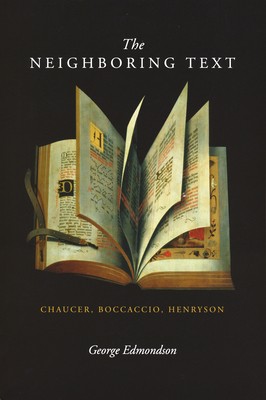
- We will send in 10–14 business days.
- Author: George Edmondson
- Publisher: University of Notre Dame Press
- ISBN-10: 0268027757
- ISBN-13: 9780268027759
- Format: 15.8 x 22.9 x 2.3 cm, softcover
- Language: English
- SAVE -10% with code: EXTRA
Reviews
Description
Most medieval texts were not really texts in the modern sense of printed, bound, stand-alone volumes, but were instead scribal productions that circulated in manuscript form, often alongside unrelated writings, thereby producing what seem to be haphazard compilations. In The Neighboring Text: Chaucer, Boccaccio, Henryson, George Edmondson argues that we have tended to apply a vertical, linear model of literary history to this late medieval manuscript culture. By contrast, he brings recent work in the fields of psychoanalysis and political philosophy to bear on the question of literary history in order to develop a countermodel informed by a horizontal ethos of "neighborliness."
Edmondson analyzes the different ways that three canonical texts--Chaucer's Troilus and Criseyde; its source, Boccaccio's Il Filostrato; and its fifteenth-century Scottish derivative, Robert Henryson's Testament of Cresseid--treat two figures, Troilus and Criseyde, and how those differences affect our understanding of literary history. He argues that what makes them neighboring texts is their shared concern with the subject of medieval Trojan historiography in general, and their very different treatments of Troilus in particular. At the same time, Edmondson supplements the medieval ideal of neighborliness with the psychoanalytic understanding of the neighbor as a figure both proximate and strange: at once the building block of community and its stumbling block. The result is a repositioning of the three works as a textual neighborhood--one in which the legendary history of Troy is transformed from the basis of imaginary national genealogies to a figure for the aggression and enjoyment, the conflicting gestures of identification and estrangement, that shape the neighbor relation.
EXTRA 10 % discount with code: EXTRA
The promotion ends in 15d.03:31:48
The discount code is valid when purchasing from 10 €. Discounts do not stack.
- Author: George Edmondson
- Publisher: University of Notre Dame Press
- ISBN-10: 0268027757
- ISBN-13: 9780268027759
- Format: 15.8 x 22.9 x 2.3 cm, softcover
- Language: English English
Most medieval texts were not really texts in the modern sense of printed, bound, stand-alone volumes, but were instead scribal productions that circulated in manuscript form, often alongside unrelated writings, thereby producing what seem to be haphazard compilations. In The Neighboring Text: Chaucer, Boccaccio, Henryson, George Edmondson argues that we have tended to apply a vertical, linear model of literary history to this late medieval manuscript culture. By contrast, he brings recent work in the fields of psychoanalysis and political philosophy to bear on the question of literary history in order to develop a countermodel informed by a horizontal ethos of "neighborliness."
Edmondson analyzes the different ways that three canonical texts--Chaucer's Troilus and Criseyde; its source, Boccaccio's Il Filostrato; and its fifteenth-century Scottish derivative, Robert Henryson's Testament of Cresseid--treat two figures, Troilus and Criseyde, and how those differences affect our understanding of literary history. He argues that what makes them neighboring texts is their shared concern with the subject of medieval Trojan historiography in general, and their very different treatments of Troilus in particular. At the same time, Edmondson supplements the medieval ideal of neighborliness with the psychoanalytic understanding of the neighbor as a figure both proximate and strange: at once the building block of community and its stumbling block. The result is a repositioning of the three works as a textual neighborhood--one in which the legendary history of Troy is transformed from the basis of imaginary national genealogies to a figure for the aggression and enjoyment, the conflicting gestures of identification and estrangement, that shape the neighbor relation.


Reviews